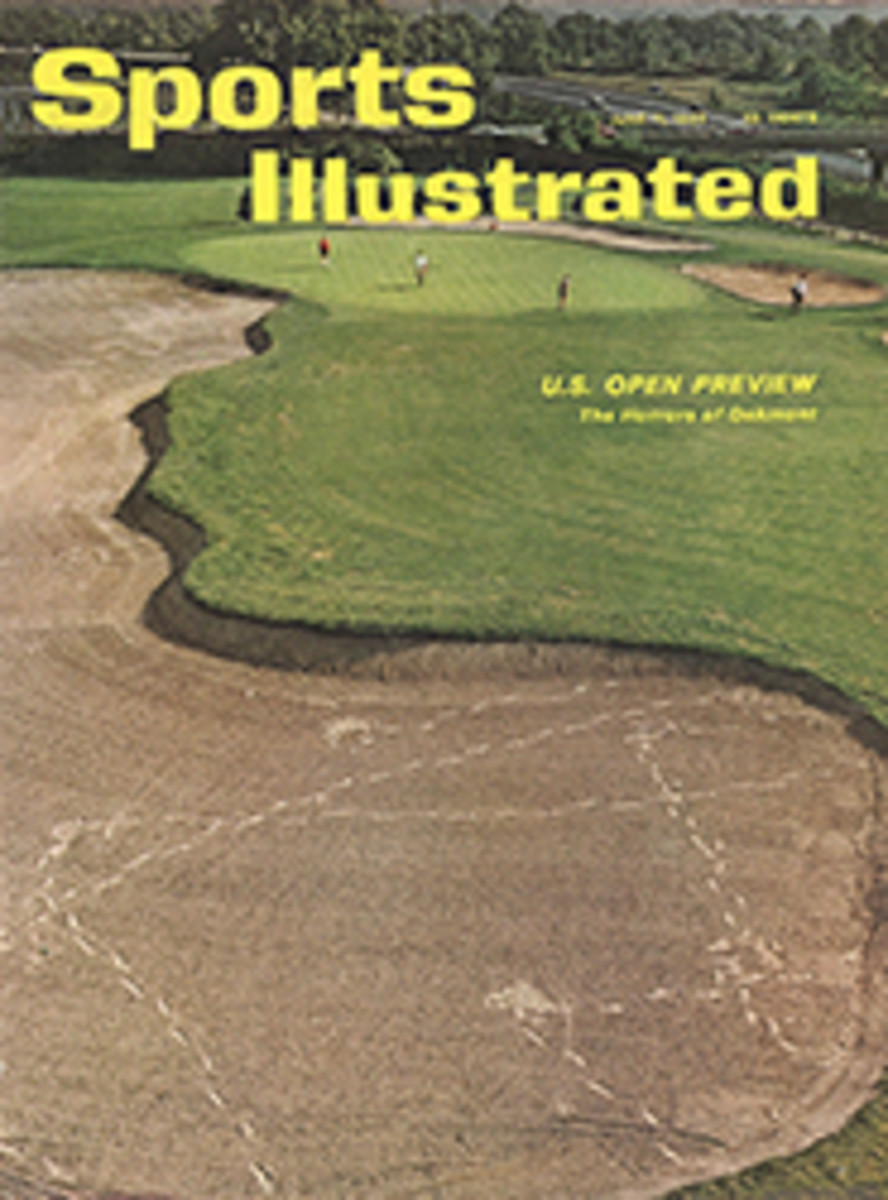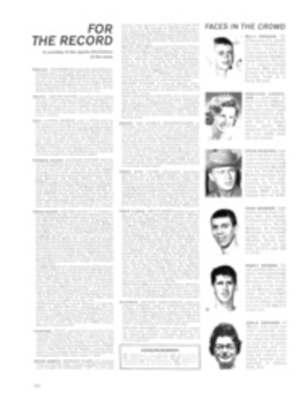
A GOLF COURSE FOR MEN OF STEEL
They begin to arrive at the site of the 62nd U.S. Open this weekend, all those golfers with the famous names: Palmer, Player, Finsterwald, Casper, Nicklaus, Sanders, Littler, Bolt. These are the men who dismember par across the flat, hard courses of the winter tour and thrive on the lush, slow greens of springtime. They are the best players, as a group, that the game has ever known. Yet they will arrive frightened half to death, not of each other but of that tough golf course: Oakmont Country Club. Though the galleries that follow them will sympathize with the plight of the pros, it is worth remembering that Oakmont does not close down the other 362 days of the year. Another group of men with famous names, too, play the course all the time—and they love it. These are the steel executives of Pittsburgh. Golf is their sport, many of them play it surprisingly well and they have found Oakmont is a wonderful place to forget about that fellow, Jack Kennedy.
"Oakmont is a real challenge, but it's not unfair," says Leslie B. Worthington, the president of U.S. Steel. "My normal game is about 85—I have a 13 handicap—and although I can't shoot that at Oakmont, I don't really mind. Hardly anyone plays to his handicap at Oakmont. The greens are too fast. I just don't have the touch to putt properly there. I play the course perhaps eight or 10 times a year. I wish I could play it more often."
Like most Oakmont members, Worthington has a certain amount of difficulty concealing his delight at the reaction of guests playing the course for the first time. "The problem is not entirely psychological," he says, "but that's part of it. Visitors have usually heard so much about the course that they are worried before they reach the first tee. Then they hit that No. 1 green and go right off the other side. It slants away from you, downhill, and it's literally possible to putt a golf ball off that green. After that, the shakes may stay with a fellow all the way around the course. As a matter of fact, the first time I played Oakmont, 20 years ago, that is exactly what happened to me."
For some reason, No. 4, a long par-5 with traps clustered down the whole right side, is the toughest hole for Worthington. "Every hole is difficult for me," he says, "but I seem to get in an awful lot of trouble there."
Edward J. Hanley, the president of Allegheny Ludlum, stays in trouble most of the time. He plays to a 28 handicap and seldom breaks 100. "I don't guess I'll ever learn this game," he says, "but I love it. I play every weekend and, for me, Oakmont is a course that a 110-shooter can enjoy. I don't find it any more difficult than some of the others.
"Let me tell you about No. 8," he says, speaking of one of golf's most famous holes, the one on this issue's cover. "I stand on the tee and all I can see is Sahara, that huge sand trap in front of the green. It must be the largest trap in the world. And then I think about what Walter Hagen did there in the '35. He went right into that trap; the ball was almost buried. So he walks in like he owns it and blasts out into the cup for a birdie. Well, I tell myself, I'm not Hagen, but if he's not going to worry about that bunker, why should I? So I just play the hole and enjoy it. I think it's a wonderful hole."
Blather from Avery
Not all of the steelmakers have as much trouble with Oakmont as Ed Hanley. Avery Adams, the chairman of the board of Jones & Laughlin, was once a scratch golfer, a contender in the annual club championship. Now Adams is 64 and his handicap is up to nine. "But if you're going to play golf with Ave Adams," warns Worthington, "don't you believe that blather he passes out about his golf game. He'll take you apart out there." Allison Maxwell, the president of Pittsburgh Steel, is in the same class, a fine amateur player who simply doesn't get out as often as he would like. Once Maxwell, too, was a scratch golfer.
"Those Oakmont handicaps mean something, too," says Donald C. Duvall, executive vice-president of Pittsburgh Steel, who is not a member of the club but plays there frequently with Robert E. Lauterbach, sales vice-president. "I have a 20 handicap, but I have a heck of a time breaking 100 at Oakmont. It's common practice to invite an 85-shooter to play the course, then bet him that he can't break 100 his first round. Man, there's a trap alongside No. 17 so deep that if you go into it they send someone along to help you climb out. Why, a man could disappear for days and days in there."
"It's a very deceptive course," says Lauterbach, who plays in the mid-90s. "From up here," and he waves out across the fairways from the porch of the graceful old clubhouse, "you can't see many of the traps. There are no tight out-of-bounds—I doubt that the pros will hit one ball out during the entire tournament. There isn't a single water hazard. There are very few trees that figure in the play. Most of the fairways are parallel. But just wait until the tournament begins.
"Those greens will be mowed short and rolled until you can barely stand on them. And look at the contours: the pin placements can be deadly. The rough has been allowed to grow until you can actually lose a golf ball three yards off the fairway. One guy was telling me that his score has gone up 10 strokes in the last two weeks, and don't think that the pros won't be in that rough, too. This isn't Augusta; these fairways are really narrow.
"Sure, they'll score well on some of the holes. No. 9 will be an easy birdie. They won't have any trouble with 14 and 17. But they'll be lucky to par 10 and 15, and some of the par-3s—8 and 16—are tough enough for anybody. I think it will be a great tournament. Everyone is talking about Palmer shooting 280 or better for the four rounds. Well, no one has ever come close to that except Hogan, with that 283 in '53, and I don't think Palmer is that much better than Hogan just yet."
Perhaps none of the steel men understand the problems of Oakmont better than Stanley McCaskey, secretary of Allegheny Ludlum and the current club senior champion. Twice runner-up for the club championship, McCaskey played at a three handicap until this year, is now at five. Once he shot the course in 70, although not from the championship tees. "I might have had a 69," he remembers, "but somebody in the foursome told me my score as we came up to 18."
McCaskey feels that Oakmont, despite its hazards, is a very honest golf course. "You are never penalized for a good shot here," he says, "nor rewarded for a bad one. But a bad shot doesn't penalize you unjustly; maybe half a stroke, on the average.
"There is only one really weak hole on the course, and that's No. 1. It plays to a par-5, but for the Open we have moved the championship tee forward and it will be a tough par-4. The pros will be hitting their second shot blind to the green. This was the big birdie hole in 1953, but I don't think we have to worry about that now. Of course this changes the par from 72 to 71, so maybe someone will go under Ben Hogan's 283, but I am not so sure. When Palmer stopped in for a practice round two weeks ago he said that he wouldn't settle for 280. Then he played the course and he changed his mind. And the greens weren't as fast then as they will be on June 14, nor the rough as deep.
"Oakmont will be a good test," says Stan McCaskey. "It always is."
PHOTO
Solving the psychological problem, says U.S. Steel's Worthington, is half the battle at Oakmont
PHOTO
Sighting through the thick rough that grows right up to the greens, Pittsburgh Steel's Lauterbach studies downhill putt

